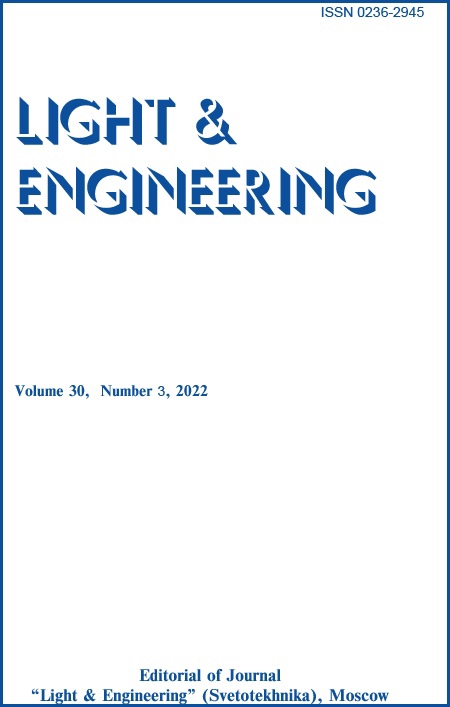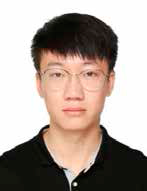Content

Abstract:
Recent studies revealed that the visual perception of temporal light modulation (TLM), particularly the visibility threshold, were illuminance dependent and subjects exhibited significantly different response at 50 lx. Some novel studies suggested TLM at 50 lx could be particularly useful in terms of promoting alertness and increasing comfort. Therefore, in this study, working performance, subjective visual fatigue and pupillary light response (PLR) were measured under different frequency of TLM at 50 lx to evaluate such phenomenon and its possible application. Results showed that all three parameters measured at 50 lx followed a U-shaped curve with the increasing frequency, instead of the monotonically increasing trend reported in earlier research at relative higher illuminance levels (300–400) lx. Comparing to 100 Hz or 1000 Hz, 300 Hz was the best in terms of visual fatigue (P<0.01) and worst in terms of working performance (P<0.01) while PLR also showed smaller percent change under 316 Hz and 562 Hz (P<0.01). These results supported the hypotheses that at 50 lx illuminance level, the relationship between the effect of TLM and frequency was non-monotonic and was different than the monotonically increasing trend discovered under higher illuminance. Furthermore, such difference not only affects working performance and visual fatigue, but also pupillary light response, which then might affect more physiological outcome. These results could potentially be useful for reducing visual fatigue at scenarios such as operating displays in vehicles or aircrafts at night.
References:
1. Veitch, J. A., Martinsons, Ch., Coyne, St., and Dam-Hansen, C. Correspondence: On the state of knowledge concerning the effects of temporal light modulation // Lighting Research & Technology, 2021, Vol. 53, pp. 89–92. 2. l’Éclairage Commission International de. Visual Aspects of Time-Modulated Lighting Systems–Definitions and Measurement Models, Vienna (Austria): CIE CIE TN2016, p. 6. 3. Lu, Sh., Cai, Y., Shen, M., Zhou, Y., and Han, Sh. Alerting and orienting of attention without visual awareness // Consciousness and cognition, 2012, #21, pp. 928–938. 4. Bullough, J.D., Sweater, H. K., Klein, TR., and Narendran, N. Effects of flicker characteristics from solid-state lighting on detection, acceptability and comfort // Lighting Research & Technology, 2011, Vol. 43, pp. 337–348. 5. Veitch, J. A. and McColl, Sh.L. Modulation of fluorescent light: Flicker rate and light source effects on visual performance and visual comfort // International Journal of Lighting Research and Technology, 1995, Vol. 27, pp. 243–256. 6. Zhao, X., Hou, D., Lin, Y., and Xu, W. The effect of stroboscopic effect on human health indicators // Lighting Research & Technology, 2020, Vol. 52, pp. 389–406. 7. Knez, I. Affective and cognitive reactions to subliminal flicker from fluorescent lighting // Consciousness and cognition, 2014, Vol. 26, pp. 97–104. 8. Kozaki, T., Hidaka, Y., Takakura, J., and Kusano, Y. Suppression of salivary melatonin secretion under 100-Hz flickering and non-flickering blue light // Journal of physiological anthropology, 2018, pp. 37: 23. 9. Perz, M., Vogels, IMLC., Sekulovski, D., Wang, L., Tu, Y., and Heynderickx, IEJ. Modeling the visibility of the stroboscopic effect occurring in temporally modulated light systems // Lighting Research & Technology, 2015, Vol. 47, pp. 281–300. 10. Berman, S. M., Greenhouse, D. S., Bailey, I. L., Clear, R. D., and Raasch, T.W. Human electroretinogram responses to video displays, fluorescent lighting, and other high frequency sources // Optometry and vision science: official publication of the American Academy of Optometry, 1991, #68, pp. 645–662. 11. Wang L., Tu, Y., Liu, L., Perz, M., Vogels, I. MLC., and Heynderickx, I. EJ. 50.2: Invited paper: stroboscopic effect of LED lighting // SID Symposium Digest of Technical Papers, Wiley Online Library, 2015, pp. 754–757. 12. Wang, L., Zhu, N., Cheng, Sh., Tu, Y., and Yang, Y. 2.1: Invited Paper: Dependence of Illumination Level on Phantom Array Effect // SID Symposium Digest of Technical Papers, Wiley Online Library, 2021, pp. 8–10. 13. Perz, M., Sekulovski, D., Vogels, I., and Heynderickx, I. Stroboscopic effect: contrast threshold function and dependence on illumination level // Journal of the Optical Society of America A, 2018, #35, pp. 309–319. 14. Yang, J., Zhang, T., Lin, Y., and Xu, W. Effect of Illuminance and Light Strobe on Attention and Visual Fatigue in Indoor Lighting // 2019 16th China International Forum on Solid State Lighting & 2019 International Forum on Wide Bandgap Semiconductors China (SSLChina: IFWS) 25–27 Nov. 2019, pp. 149–152. 15. Figueiro, M. G. and Pedler, D. Red light: A novel, non-pharmacological intervention to promote alertness in shift workers // Journal of Safety Research, 2020, #74, pp. 169–177. 16. Chen, L., Yan, F.-F., Fan, Sh., Wu, Y., Yang, J.,Yang, H., and Huang, Ch.-B. The effects of short-term light exposure on subjective affect and comfort are dependent on the lighting time of day // Scientific Reports, 2021, #11, p. 2604. 17. Chi, Ch.-F., and Lin, F.-T. A Comparison of Seven Visual Fatigue Assessment Techniques in Three Data-Acquisition VDT Tasks // Human Factors, 1998, #40, pp. 577–590. 18. Gray, L. S., Gilmartin, B., and Winn, B. Accommodation micro fluctuations and pupil size during sustained viewing of visual display terminals // Ophthalmic and Physiological Optics, 2000, #20, pp. 5–10. 19. Bates, M. E. and Lemay Jr. E.P. The d2 Test of attention: construct validity and extensions in scoring techniques // Journal of the International Neuropsychological Society: JINS, 2004, #10, p. 392. 20. Lee, P., Lu, W.-Sh., Liu, Ch.-H., Lin, H.-Y., and Hsieh, Ch.-L. Test–retest reliability and minimal detectable change of the D2 test of attention in patients with schizophrenia // Archives of Clinical Neuropsychology, 2018, #33, pp. 1060–1068. 21. Hayes, J. R., Sheedy, J. E., Stelmack, J. A., and Heaney, C.A. Computer Use, Symptoms, and Quality of Life // Optometry and Vision Science, 2007, #84, pp. E738-E755. 22. Antona, B., Barrio, A. R., Gascó, A., Pinar, A., González-Pérez, M., and Puell, M.C. Symptoms associated with reading from a smartphone in conditions of light and dark // Applied Ergonomics, 2018, #68, pp. 12–17. 23. Chu, Ch., Rosenfield, M., Portello, J. K., Benzoni, J. A., and Collier, J. D. A comparison of symptoms after viewing text on a computer screen and hardcopy // Ophthalmic and Physiological Optics, 2011, #31, pp. 29–32. 24. Zele, A. J., Feigl, B., Smith, S. S., and Markwell, E.L. The Circadian Response of Intrinsically Photosensitive Retinal Ganglion Cells // PLOS one, 2011, #6, p. e17860. 25. Münch, M., Léon, L., Crippa, S. V., and Kawasaki, A. Circadian and Wake-Dependent Effects on the Pupil Light Reflex in Response to Narrow-Bandwidth Light Pulses // Investigative Ophthalmology & Visual Science, 2012, #53, pp. 4546–4555. 26. Golden, R. N., Gaynes, B. N., Ekstrom, R. D., Hamer, R. M., Jacobsen, F. M., Suppes, T., Wisner, K. L., Nemeroff, Ch.B. The Efficacy of Light Therapy in the Treatment of Mood Disorders: A Review and Meta-Analysis of the Evidence // American Journal of Psychiatry, 2005, #162, pp. 656–662. 27. Vartanian, G. V., Zhao, X., and Wong, K.Y. Using Flickering Light to Enhance Nonimage-Forming Visual Stimulation in Humans // Investigative Ophthalmology & Visual Science, 2015, #56, pp. 4680–4688. 28. Zandi, B., Lode, M., Herzog, Al., Sakas, G., and Khanh, T.Q. PupilEXT: Flexible Open-Source Platform for High-Resolution Pupillometry in Vision Research // Frontiers in Neuroscience, 2021, #15. 29. Santini, Th., Fuhl, W., and Kasneci, En. PuReST: robust pupil tracking for real-time pervasive eye tracking // Proceedings of the 2018 ACM Symposium on Eye Tracking Research & Applications. Warsaw, Poland: Association for Computing Machinery, 2018, p. Article 61. 30. Adhikari, P., Feigl, B., and Zele, A.J. The flicker Pupil Light Response (fPLR) // Translational Vision Science & Technology, 2019, P. 8. 31. Binda, P. and Gamlin, P.D. Renewed Attention on the Pupil Light Reflex // TRENDS in Neurosciences, 2017, #40, pp. 455–457. 32. McDougal, D. H. and Gamlin, P.D. Autonomic control of the eye // Compr Physiol, 2015, #5, pp. 439–473. 33. Nevvab, M. Human factors and dynamic roadways and in-vehicle lighting conditions // Conference Record of the 1991 IEEE Industry Applications Society Annual Meeting 28 Sept.-4 Oct. 1991, Vol. 1902, pp. 1904– 1910. 34. Böhm, H.-DV., Frank, J., and Haisch, S. Helicopter NVG compatible cockpit illumination assessments, 1992. 35. GB50034–2013 Standard for lighting design of buildings
Keywords
Recommended articles
Effects Of Spectral Tuning Of White Light on Attention Level And Sleep Quality L&E, Vol. 29, No. 3, 2021






